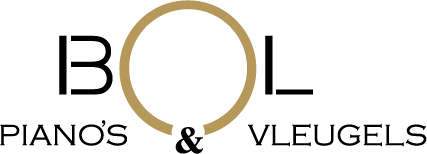
The Dutch contribution to the development of the piano
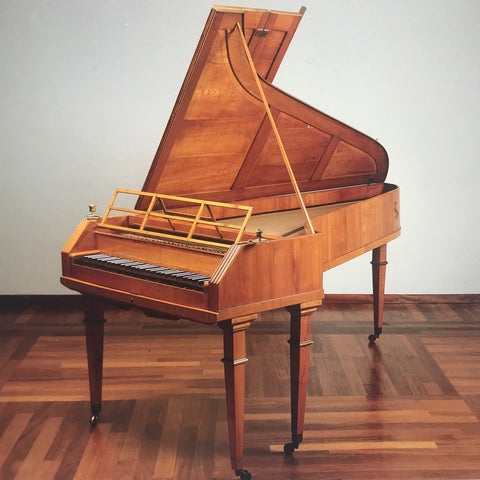
Grand piano by J.L. Dulcken, 1794.
This instrument by Jan Lodewijk Dulcken is considered one of the first Dutch grand pianos (based on a model by J.A. Stein).
--------------------------------------------------------------------------------------------------------------------------------------
The 18th century has, broadly speaking, three different types of stringed instruments with keys: the harpsichord, the clavichord and the pianoforte. These instruments can easily be distinguished from each other by the way the strings are sounded. The most widespread and technically developed was the harpsichord, the strings of which are plucked by means of raven pins. The clavichord was much more modest in tone and construction. The strings are struck with a metal stilt.
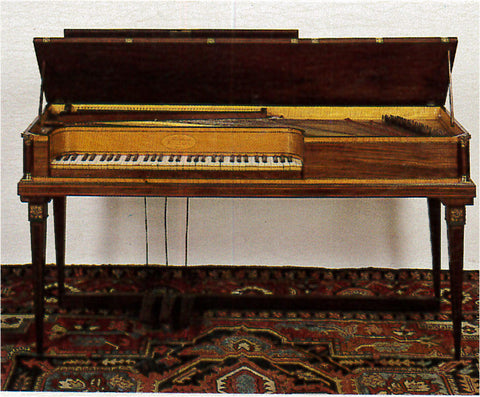
Table piano by P. Fabritius, The Hague, 1808. This instrument by "Faiseur d'instruments de musique" P. Fabritius is the oldest preserved table piano from The Hague. It is notable for its balanced design in Empire style and for its refined combination of wood types (Mahogany and Maple, with decorative bands of satin wood.)
Finally, the 18th century brought the development of a new keyboard instrument, the pianoforte. In the fortepiano, the strings are struck with a hammer mechanism. Although the pianoforte initially had a lot of competition from the clavichord and the harpsichord, interest in the fortepiano soon increased. As a result, many instrument makers focused more and more on building pianofortes. In the first half of the 18th century this happened very occasionally. Only after 1760 can one speak of somewhat regular production. This is how pianoforte building centers emerged in various European countries.
The development of the piano in the Netherlands.
What was the situation in the Netherlands now? Among the largest centers in England, France, Germany and Austria, pianoforte building in the Netherlands occupied a relatively modest place. There are various reasons for this. The United Netherlands was only able to recover slowly after the major political and economic shifts caused by the French Revolution. There was only an economic boom after 1814.
If we want to determine when instrument makers in the Netherlands became interested in the pianoforte, we have to rely on scarce newspaper reports. The earliest mention is found in the Amsterdam Courant of Saturday, July 15, 1758, in which the organ builder Hendrik Blatz offers for sale two 'superb Forte Piano, being Hamerwerk'.
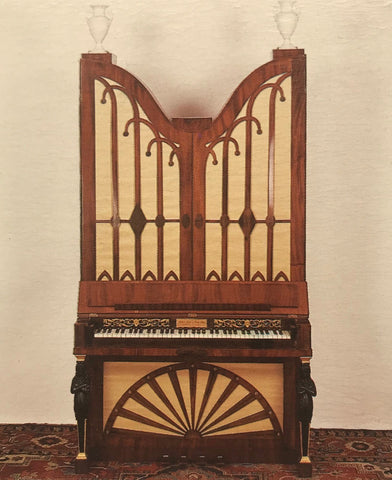
Apollopiano by Meincke and Pieter Meyer Amsterdam, ca.1815. The very special model of this piano comes from the Viennese piano builders J. Wachtl and J.F. Bleyer. The copy depicted here has stood in the Amsterdam Palace on Dam Square since the 1st century. In 1962 it was loaned by the Royal House to the Hague Municipal Museum.
Much later, in 1779, the same newspaper reported that Meincke Meyer, coming from London where he was the partner of Joh. Zumpe established himself as a pianoforte builder with his brother Pieter in Amsterdam. These reports show that the pianoforte had been known in the capital since at least the mid-18th century. M. and P. Meyer were probably the first to dare to undertake regular production here. Naturally, other builders followed suit.
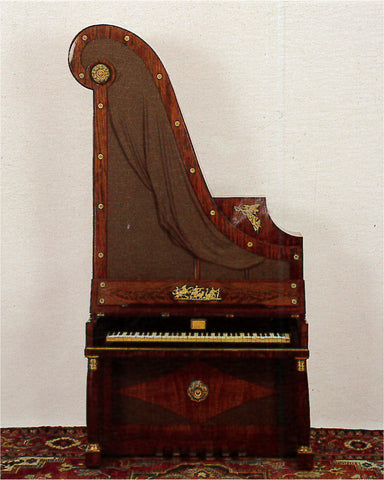
Giraffe piano by J. van Raay, Amsterdam, ca. 1825. Joannes van Raay was one of the most important Dutch piano builders. This luxurious Biedermeier style instrument has a mahogany case, with both removable front panels covered with dark green fabric. Giraffe pianos often have an exceptionally large number of pedals. The six pedals of this instrument have the following functions: mute, bassoon (bass side), dolce (bass side), dolce (whole), shift, triangle with drum.
It is not known to what extent this still happened in the last decades of the 18th century. What is certain is that outside Amsterdam the construction of pianofortes only really got underway after 1800. It was not only Dutch who worked in pianoforte construction here. Many professionals came, especially from Germany, who either went to work for a Dutch builder or set up their own company. From a technical point of view, the Dutch builders mainly focused on English technology, especially that of the company J. Broadwood & Sons.
Many foreign fortepianos were probably also made here under license. Some types of hammer keyboards. The term piano forte used so far requires further explanation. This term goes back to the founder of pianoforte construction, the Italian Cristofori, who gave his new instrument the name 'gravicembalo col piano e forte' (harpsichord with soft and hard). This later gave rise to two names: pianoforte and fortepiano, which were used interchangeably in different countries as a collective name for a keyboard instrument with hammers (hammer keyboard).

Upright piano by J. van Raay I. & Zonen, Amsterdam, ca.1840.
Dutch examples of upright pianos are a great rarity. The case of this model is made of mahogany with inlaid brass piping. The fairly far-out keyboard is supported by legs in the shape of a violin curl, fitted with metal claws. The lower and upper cabinets have doors.
Over the course of the 18th century, various types of hammer keyboards were developed, gradually gaining their own names:
wing (strings horizontal, in line with the keys; asymmetrical model)
tafelpiano (strings horizontal, perpendicular to the keys; wide, right-angled model)
giraffepiano (strings vertical; high asymmetric model).
Piramidepiano (strings almost vertical; pyramidal model)
Cabinet piano (strings vertical; fairly high rectangular model)
As the last descendant, our current piano (pianino) was created in the 19th century (strings vertical and/or inclined; rectangular model).

Pyramid piano by J. van Raay & Zonen Amsterdam, ca.1840. This is the only pyramid-shaped piano that, as far as we know, has been preserved from the Van Raay company. Although production figures are lacking, it appears that the strictly symmetrical pyramid pianos were generally less popular than the giraffe pianos. There are four pedals: shift (1 string is played), shift . (2 strings are struck), dolce, muting.
The Dutch instrument makers of that time focused almost exclusively on the production of table pianos. This type was the most common in the living room, certainly until around 1840. The manufacture of wings is much more expensive and was mainly omitted for economic reasons. It is striking, however, that quite a lot of giraffe pianos were also built in the Netherlands in the first half of the 1st century. New developments. After the meteoric rise of the piano in the 18th century, development virtually came to a standstill in the mid-19th century. Not that the instrument would therefore be less popular, on the contrary. However, we had to wait for newer, better and more refined production techniques. Techniques that were only discovered during and after the Industrial Revolution around 1900. SPI The Netherlands initially played a rather modest role in it. field of production and improvement of pianos, this changed after 1900. Dutch piano makers of that time included JF Cuypers, C. Quispel, MJH Kessels, A. Mes and A. Hahn. In 1937, JJ Rippen once again laid the foundation for a Dutch piano factory.
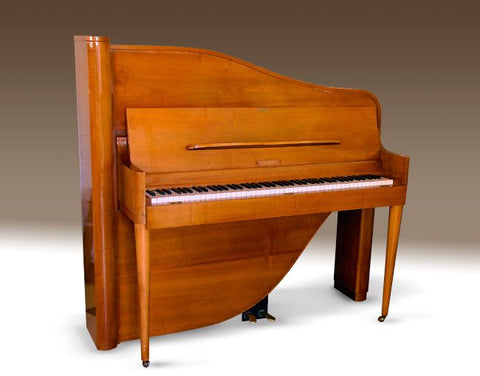
Maestropiano van JJ Rippen
The Hague, 1937.
JJ Rippen 's first piano. It is clearly visible how the body of the piano reflects the shape of the long strings. follows. Because all strings. Walking over a ridge in this model creates a. full uniform sound character from high to low.
The first piano with which Rippen became famous was the “Maestro”. JJ Rippen said: “Start by drawing the short strings up to the long bass strings. Keep all strings parallel and place them over a continuous bridge, creating a completely uniform sound character from high to low.
Then build the case functionally around this design, following the lines of the long and short strings as is usual with the grand piano and the harp. The result must be: an ideal tone and an ideal design." Another invention was the use of a so-called Rippen Perma-tone soundboard. A soundboard amplifies and colors the tone generated by the vibrating string. For a sustainable tone quality, the construction of a soundboard is therefore vital.
The Rippen soundboard is made from the finest coniferous wood from Canada and Romania. Trees that grow slowly and straight up on the leaner, colder mountain slopes that are remote from the sun. This creates the all-important straight structure with closely spaced annual rings. The soundboard of a Rippen piano retains its tone-shaping quality, even with changes in temperature or humidity.
While Rippen originally only built his pianos as a hobby, after the successful introduction of the Maestro, Rippen quickly grew into a family business where craftsmanship, dedication and experience were passed on from father to son.
But of course, at Rippen we do not only have to rely on professionalism and experience. Thanks to modern techniques such as analyzing the tone quality, and close collaboration with scientists and musicians, the quality and durability of the pianos has continued to improve.
And when we talk about sustainability and quality, we should not leave out the control thereof. At Rippen every phase in the production process is concluded with an inspection. This means that there is strict control in the selection of the materials used, in the processing of the wood, in the manufacture of the frame, in the assembly of the strings and the soundboard, in tuning and in adjustment.
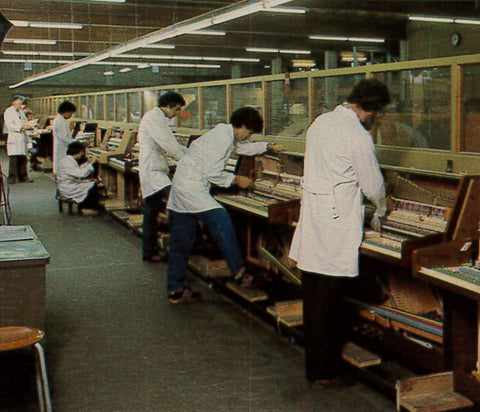
Adjustment and control. Adjusting a piano is a precise job that requires a lot of skill and experience. After mounting the mechanism and keyboard, everything is thoroughly checked again. Only when everything has been found to be in order is the piano-to-be ready for the next phase of the production process.
This is the only way that Rippen can be sure that all the attention and care that has gone into the construction of the pianos will be 100% effective in practice.
Unfortunately, at the end of the last century, Rippen ceased to exist in the Netherlands as an independent Dutch piano manufacturer. The Bol pianos company in Veenendaal, the Netherlands, is now the new owner of the rights and designs and the pianos will be assembled again from Veenendaal in the course of 2018. The pianos are exported worldwide.
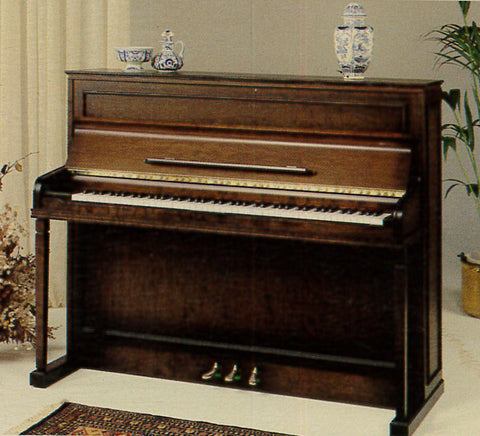
Rippen 's Romance
Together with the Belcanto and Nocturne, the Romance is a much sought-after model from the Rippen range. The balanced sound character, the sublime tonal quality and the stylish appearance are certainly no exception.
The fact that people abroad also appreciated solid Dutch craftsmanship is proven by the fact that Rippen pianos were exported all over the world.
